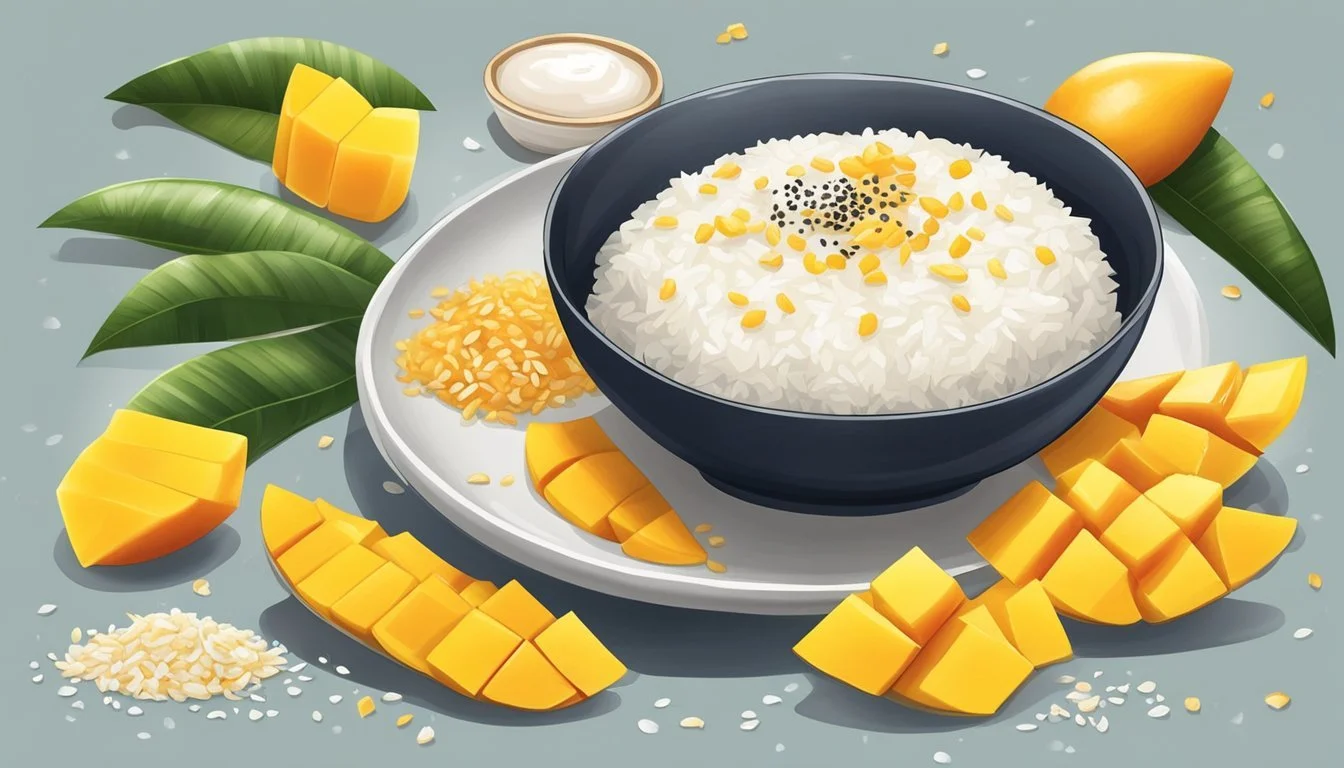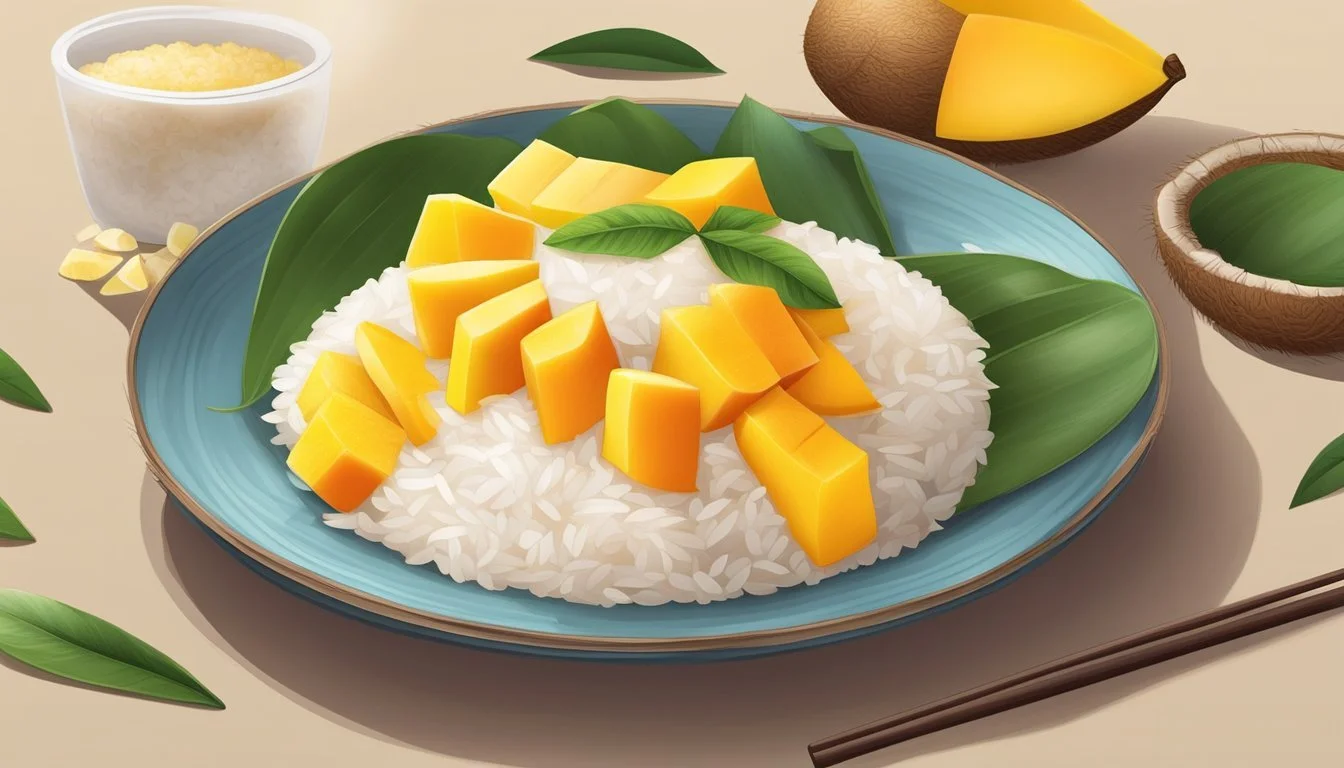How Do You Eat Mango Sticky Rice?
A Step-by-Step Guide
Mango sticky rice (What wine goes well with rice?) is a beloved dessert that originates from Thailand and is a staple in Asian cuisine. Known for its perfect blend of sweetness and creaminess, it pairs the tropical flavor of ripe mango with the unique texture of glutinous rice, known as sticky rice. The dish is typically served with a drizzle of coconut sauce that enriches every bite with its aromatic and luxurious flavor. This dessert is not only a cultural icon in Thailand but has also captivated the palates of people all around the world.
The preparation of mango sticky rice often begins with the careful selection of quality ingredients. Thais traditionally enjoy this dish using nam dok mai mangoes, which are known for their sweet and tender flesh, but other varieties can be used as well. The glutinous rice is soaked, then steamed until it reaches the desired sticky consistency. It is slightly salted, sometimes sweetened, and occasionally enhanced with a sprinkle of toasted sesame seeds or mung beans for textural contrast.
To assemble the dessert, the warm sticky rice is placed on a plate, accompanied by slices or cubes of ripe mango. The coconut sauce, made from coconut milk, sugar, and a pinch of salt, is then gently poured over, marrying the distinct flavors of the rice and mango. Mango sticky rice is enjoyed throughout the year but is particularly popular in the summer months when mangoes are at their peak of ripeness.
Understanding Mango Sticky Rice
Mango sticky rice is a traditional Thai dessert renowned for its sweet, creamy taste and the delightful contrast between the rich taste of coconut milk and the freshness of ripe mangoes. This dessert is a staple of Thai cuisine and is often found served as street food, enjoyed by locals and tourists alike for its authentic flavors.
Historical Significance
Mango sticky rice, known in Thai as "khao niew mamuang," has deep roots in Thai culture that testify to the long-standing cultivation of rice and mangoes in the region. It's a dish that encapsulates the essence of Thai street food and is commonly associated with the warm, festive seasons when mangoes are most abundant. The combination of sweet rice with mango began as a simple, yet ingenious way to enjoy two of Thailand's most beloved harvests. Over time, it has become a celebrated dessert recipe in both domestic and international circles, embodying the heart of Thai dessert traditions.
Key Ingredients
Rice: This dessert is made with Thai sweet rice, also known as Thai glutinous rice or sweet rice. This particular type of rice gains a sticky texture after being properly cooked, which is essential for the dish.
Mango: Ripe mangoes are a crucial component. The sweet and juicy flesh contrasts perfectly with the sticky rice and adds a burst of natural flavor.
Coconut Milk: Coconut milk is used to infuse the glutinous rice with a rich, creamy flavor that balances the sweetness of the mango.
Sugar and Salt: Typically, sugar is added to sweeten the coconut milk, while a pinch of salt enhances all the flavors.
Coconut Cream: Often, coconut cream is drizzled on top of the dish before serving to add luxurious creaminess.
Optional Toppings: Some recipes may include toasted sesame seeds or crispy mung beans for extra texture and flavor.
The ingredients are simple, yet the combination of the sweet and slightly salty rice with the aromatic ripeness of mango creates a harmony of flavors that sets mango sticky rice apart from other rice pudding variations within Thai dessert recipes.
Preparation Process
Creating a delicious plate of mango sticky rice requires a clear understanding of each step in the preparation process. From choosing the perfect mango to the final assembly, attention to detail is key to achieving an authentic and flavorful dish.
Choosing the Right Mango
For the best mango sticky rice, Ataulfo or Nam Dok Mai mangoes are the ideal choices during mango season. They should be ripe, boasting a sweet aroma and slight give when pressed gently.
Preparing the Rice
Begin by selecting glutinous rice (also known as sticky rice or sweet rice) for its distinct texture. Rinse the rice thoroughly in cold water until the water runs clear to remove excess starch.
Cooking the Rice
Properly cooking sticky rice typically involves steaming, a method that preserves its unique chewy texture. Rinse the rice, soak in water for several hours, then drain and steam for about 15-20 minutes or until translucent and tender.
Making the Coconut Sauce
In a small saucepan, combine coconut milk, a pinch of salt, and brown sugar or granulated sugar. Heat the mixture to a gentle boil, then simmer until the sugar dissolves, making a sweetened coconut sauce.
Assembly of the Dish
For assembly, spread the warm, steamed sticky rice on a plate. Slice the ripe mango and place it atop the rice. Drizzle with the warm coconut sauce, and if desired, sprinkle a bit of toasted sesame seeds or mung beans for added texture and a nutty flavor.
Serving and Presentation
When serving mango sticky rice, the focus should center on balancing the authentic sweet and salty flavors while executing a visually appealing presentation. Temperature plays a role too, with options to serve at room temperature or chilled.
How to Serve Mango Sticky Rice
Mango sticky rice is traditionally served either at room temperature or chilled, depending on personal preferences or regional customs. The dish consists of two main components: coconut-infused sticky rice and ripe mango slices. Typically, one would spoon an ample portion of sticky rice onto a plate or bowl, then arrange slices of mango either on top or beside the rice. Drizzling coconut sauce over the sticky rice is an essential step, ensuring that every bite captures the harmonious blend of the rich coconut and the fruity sweetness of the mango.
Garnishes and Toppings
Garnishes and toppings add not only a burst of flavor but also an enticing texture contrast to mango sticky rice. Here is a list of popular garnishes that can be added:
Toasted Sesame Seeds: Sprinkle a few toasted sesame seeds over the dish to introduce a subtle, nutty aroma.
Toasted Mung Beans: Crushed toasted mung beans offer a delightful crunch that contrasts with the softness of the rice and mango.
Coconut Flakes: Garnish with coconut flakes for a boost of coconutty texture.
These garnishes serve to enhance the existing flavors while contributing to an aesthetically pleasing dish.
Culinary Tips and Variations
Mango sticky rice is a versatile dish that allows for numerous adaptations to meet diverse dietary needs and taste preferences. By embracing alternative ingredients and cooking methods, one can tailor this classic dessert to fit a gluten-free or vegan diet, and even utilize leftovers with ease.
Selecting Alternatives
Grain Selection: Jasmine rice is traditional for its fragrance and sticky qualities, but for those desiring a different texture or having leftovers, there are choices:
Sushi (What wine goes well with sushi?) rice or mochi rice can substitute with their similarly sticky properties.
While waxy rice varieties offer a gluten-free alternative, they may not be as sticky as jasmine rice but still yield a satisfactory result.
Basmati rice lacks the sticky texture but can be used for a unique twist, especially if it's what's already in the pantry.
Dietary Adaptations:
For a gluten-free version, ensure all sauces and any additional ingredients are certified gluten-free.
A vegan adaptation requires substituting regular coconut milk with a certified vegan brand to avoid any cross-contamination with animal products.
Utilizing Leftovers:
Leftover rice can be revitalized for this dish by gently warming it and adding a bit of water to restore moisture before combining it with the other ingredients.
By considering these alternatives, mango sticky rice can maintain its delightful essence while being enjoyed in new and inclusive ways.
Nutritional Information
When considering the nutritional aspects of mango sticky rice, it's essential to focus on its caloric content and the balance of carbohydrates, fats, and additional nutritional elements.
Caloric and Nutritional Content
Mango sticky rice can vary in caloric content depending on its serving size and specific ingredients used. Generally, a serving of mango sticky rice contains about:
Calories: 170 to 310 calories
Carbohydrates: High in carbohydrates due to rice and mango
Fats: Moderate fat content, sourced mainly from the coconut milk
A typical serving size, which could be approximately half a package or a standard portion served in a restaurant, provides a mix of sweet and tart flavors from the ripe mango paired with the chewy texture of the sticky rice. This dessert is also characterized by the subtle saltiness, contributed by the coconut milk, which contains added salt.
Nutrition Facts per serving (0.5 package, 74g approximately):
Calories: 310 kcal
Calories from Fat: 72 kcal (23.2% of total calories)
Total Fat: 8g
Saturated Fat: Information not specified
Cholesterol: Information not specified
Sodium: Information not specified
Total Carbohydrates: High due to sticky rice and natural sugars in mango
Dietary Fiber: Information not specified
Sugars: Natural sugars from mango
Protein: Information not specified
Vitamins and Minerals: Nutritional values for vitamins and minerals depend on the brand and specific ingredients used.
It's important to note that adding relishes or other toppings to the dish could increase its calorie and sugar content. Mango sticky rice, while delicious, should be consumed in moderation as part of a balanced diet.
FAQs About Mango Sticky Rice
What is Mango Sticky Rice?
Mango sticky rice, also known as Khao Niaow Ma Muang in Thai, is a traditional Southeast Asian dessert. It contains glutinous rice (Hua Kati) which is sweetened with coconut milk and served with ripe mango slices (Mamuang).
Where can I buy ingredients for Mango Sticky Rice?
Ingredients are often found at Asian grocers. Thai restaurants may also provide the precooked dessert on their menu, offering a taste comparable to the ones found in Southeast Asia.
How is Mango Sticky Rice properly eaten?
This dessert is typically eaten with a fork and spoon, enabling the diner to combine the sweet, coconut-flavored rice with the fresh mango in each bite.
Is Mango Sticky Rice similar to dishes like Pad Thai?
Although both are staples in Thai cuisine, they differ greatly. Mango Sticky Rice is a sweet dish primarily served as dessert, while Pad Thai is a savory noodle dish enjoyed as a main course.
Does the grain of rice matter?
Yes, it's essential to use glutinous or "sticky" rice, known for its high starch content, which becomes tender and sticky when cooked. This distinct texture is crucial to the dish.
Is it challenging to make Mango Sticky Rice at home?
The process is straightforward as long as one has access to the proper ingredients. The rice must be soaked, steamed, and then mixed with coconut milk and sugar, paired with fresh, ripe mango. Preparing it at home allows for adjusting sweetness to taste.
When is the best time to enjoy Mango Sticky Rice?
Although it can be enjoyed year-round, the peak season for mangoes in Southeast Asia is from April to May, which many consider the optimal time for this dessert.






